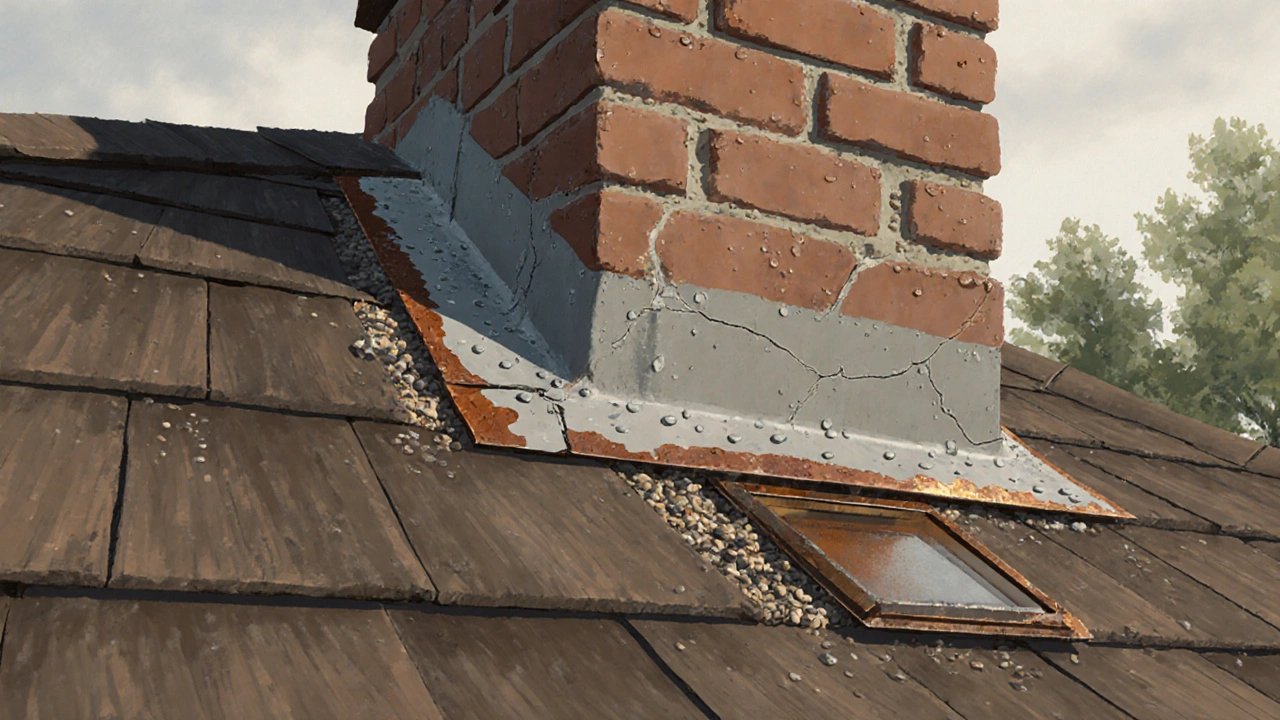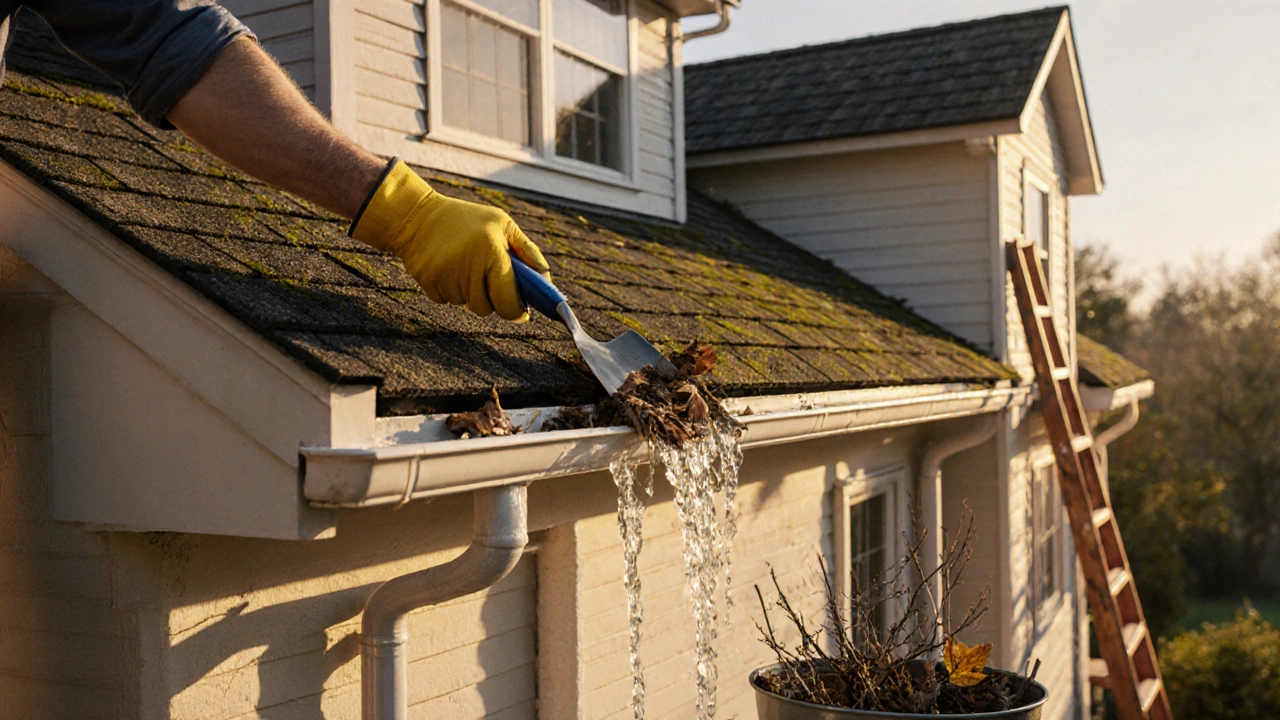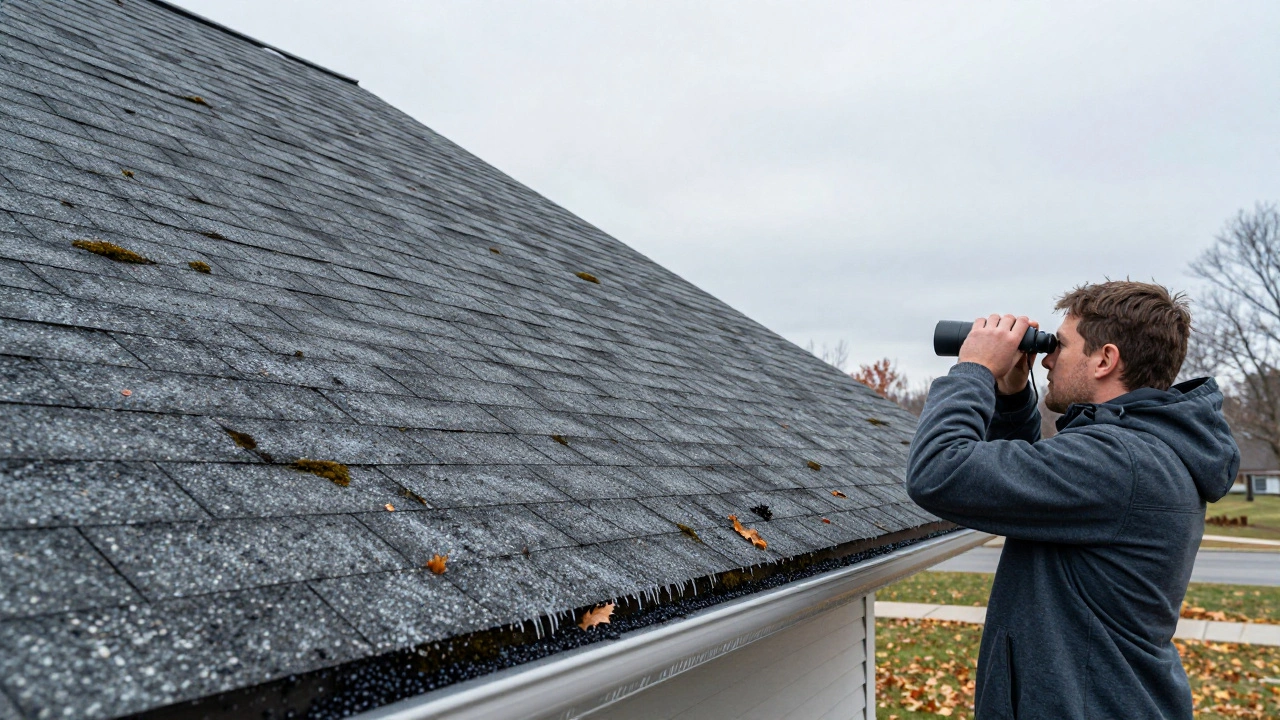Most homeowners don’t think about their roof until it starts leaking. By then, it’s often too late to fix just a few shingles. A well-maintained roof can last 20 to 30 years-or even longer. But that only happens if you do the small things, regularly. Skipping maintenance doesn’t save money. It just makes the next repair bigger, costlier, and messier.
Check Gutters and Downspouts Twice a Year
Gutters are the first line of defense. When they clog, water backs up under shingles, rots fascia boards, and pools near your foundation. Leaves, twigs, and pine needles build up fast, especially under trees. Clean them in late spring and again in early fall. Use a sturdy ladder, gloves, and a trowel. Don’t just scoop out debris-flush the downspouts with a hose to make sure water flows freely. If water doesn’t drain after flushing, there’s a blockage deeper in the pipe. That needs attention before winter freezes turn standing water into ice dams.
Look for Missing, Cracked, or Curling Shingles
Shingles protect your roof from rain, snow, and sun. Over time, they wear out. Look for shingles that are lifting at the edges, cracked, or completely missing. These are red flags. A single missing shingle lets water in. A row of curling ones means the whole section is aging faster than expected. Check from the ground with binoculars, or climb up carefully. Pay attention to areas around chimneys, vents, and skylights-these are common spots for leaks. If you see granules in your gutters, that’s a sign your shingles are breaking down. Asphalt shingles lose granules naturally over time, but if you’re seeing clumps every season, it’s time to plan for a replacement.
Inspect Flashing Around Roof Penetrations
Flashing is the thin metal or rubber strips around chimneys, vents, pipes, and roof valleys. Its job is to seal gaps where water could sneak in. Over time, flashing can loosen, rust, or crack. Check for gaps, peeling sealant, or rust spots. If you see water stains on your attic ceiling near a vent or chimney, flashing is likely the culprit. Re-seal with roofing cement if it’s just dried out. If the metal is corroded or bent, replace it. Don’t wait for a leak to show up inside-by then, the wood underneath may already be rotting.
Clear Debris from the Roof Surface
Tree branches that hang over your roof drop leaves, seeds, and small branches. Moss and algae can grow in shaded, damp areas, especially on north-facing slopes. Moss holds moisture against shingles, accelerating decay. Algae doesn’t damage the roof directly, but it’s a sign of lingering dampness. Use a soft brush or low-pressure hose to gently remove debris. Never use a pressure washer-it strips granules and damages shingles. If moss is thick, treat it with a zinc strip or a roof-safe moss killer. Apply in early spring before the rainy season hits.

Check Attic Ventilation and Insulation
Your roof doesn’t just sit on top of your house-it works with it. Poor attic ventilation traps heat and moisture in winter, causing ice dams and mold. In summer, it makes your AC work harder. Check that soffit vents aren’t blocked by insulation. Make sure ridge vents are clear. Look for signs of condensation on rafters or dark, damp spots on wood. If you see frost in winter, that’s a warning. Add more insulation if your attic floor has less than 12 inches of fiberglass or cellulose. Proper airflow keeps your roof dry and your energy bills lower.
Look for Sagging or Soft Spots
Walk through your attic and look up. Are any rafters bent? Is the roof deck soft when you press on it? A sagging roofline or spongy feeling underfoot means structural damage. This isn’t something you fix with caulk or new shingles. It’s a sign of water damage, rot, or overloaded weight from snow or stored items. If you find soft spots, stop climbing on the roof. Call a professional immediately. Ignoring this can lead to collapse-especially under heavy snow or rain.
Trim Overhanging Tree Branches
Branches that touch your roof are a double problem. They scrape shingles during windstorms, wearing them down. They also drop debris and shade the roof, encouraging moss and algae. Keep branches at least 6 feet away from the roofline. Use a professional arborist if the tree is large or near power lines. Cutting your own branches above a roof is dangerous and often illegal in urban areas. A clean perimeter reduces damage risk and makes inspections easier.

Schedule a Professional Inspection Every 3-5 Years
Even if you do all the above, you might miss hidden damage. A licensed roofing contractor can spot problems you can’t see-from underneath the shingles to the condition of the underlayment. They’ll check for nail pops, improper installation, or signs of previous poor repairs. Ask for a written report with photos. If they recommend repairs, get a second opinion if the cost is high. Reputable contractors won’t pressure you into a full replacement unless it’s truly needed. Many offer free inspections-take advantage.
Keep Records of All Maintenance
When you clean gutters, take a photo. Note the date and what you found. Same with repairs. Keep a folder or digital log. This helps you track patterns-like if moss keeps coming back in the same corner. It also helps if you sell your home. Buyers and inspectors love a homeowner who kept records. It shows you cared for the property. In some cases, it even helps with warranty claims.
What Happens If You Ignore Roof Maintenance?
Let’s say you skip cleaning gutters for two years. Water backs up. It seeps under shingles. The wood underneath rots. You don’t notice until water drips into your bedroom during a storm. Now you’re not just replacing shingles-you’re replacing sheathing, insulation, drywall, and maybe even ceiling joists. The cost jumps from $300 to $8,000. That’s not an exaggeration. Insurance might not cover it if they find you neglected routine care. Roof damage from neglect is often excluded from claims.
Another example: moss grows unchecked for five years. It lifts shingles. Water gets in. Mold spreads in the attic. Air quality drops. Health issues start. You thought you were saving money by not fixing it. You ended up paying more in medical bills and lost property value.
Roof maintenance isn’t optional. It’s the cheapest insurance you’ll ever buy.
How often should I clean my roof gutters?
Clean gutters at least twice a year-once in late spring and again in early fall. If you have lots of trees nearby, check them every three months during leaf-fall season. Clogged gutters cause water damage, ice dams, and foundation issues.
Can I walk on my roof to check for damage?
You can, but it’s risky. Most roofs aren’t designed for regular foot traffic. Walking on them can crack shingles or damage flashing. If you must go up, wear soft-soled shoes, step only on the lower third of shingles (where they’re supported by the deck), and avoid wet or icy conditions. For most checks, use binoculars from the ground.
What’s the most common cause of roof leaks?
The most common cause is failed flashing around chimneys, vents, and skylights. Second is damaged or missing shingles, especially near edges or in valleys. Poor installation and aging materials are behind most leaks-not sudden storms.
How do I know if my roof needs replacing?
Signs include: shingles that are curling, cracking, or bald (missing granules), multiple leaks that keep coming back, sagging roof deck, or if your roof is over 20 years old. If more than 30% of the surface is damaged, replacement is usually more cost-effective than repeated repairs.
Does moss really damage a roof?
Yes. Moss holds moisture against shingles, causing them to rot from underneath. It can lift shingles, create gaps, and trap debris. Over time, this leads to leaks and wood decay. It’s not just unsightly-it’s a structural threat.
Is roof maintenance covered by home insurance?
Routine maintenance is not covered. Insurance pays for sudden damage like hail, wind, or fire. But if you neglect upkeep and a leak causes mold or structural damage, your claim might be denied. Insurance companies look for signs of neglect before approving payouts.
What to Do Next
Start with a simple checklist: clean gutters this week, check for missing shingles this weekend, and take a photo of your attic for reference. Do one thing each month. That’s all it takes to keep your roof in good shape. You don’t need to be an expert. You just need to be consistent. The next time it rains, you’ll be glad you did.


